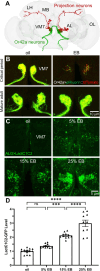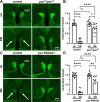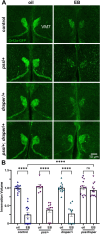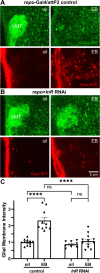Neuron-to-glia signaling drives critical period experience-dependent synapse pruning
- PMID: 40670566
- PMCID: PMC12267418
- DOI: 10.1038/s41598-025-11528-3
Neuron-to-glia signaling drives critical period experience-dependent synapse pruning
Abstract
Critical periods enable early-life synaptic connectivity optimization whereby initial sensory experience remodels circuits to a variable environment. In the Drosophila juvenile brain, synapse remodeling occurs within the precisely-mapped olfactory circuit, which has an extensively characterized, manageably short (< 1 week) critical period. In this brain circuit, single receptor olfactory sensory neuron (OSN) classes synapse onto single projection neurons extending to the central mushroom body learning/memory center. Critical period odorant experience drives OSN synapse remodeling, which can only be reversed during this brief interval. Our objective is to dissect intercellular signaling pathways from neurons to glial phagocytes sculpting synapse elimination in response to critical period experience. We find critical period experience causes externalized phosphatidylserine (PS) exposure in activated OSN synaptic glomeruli in an experiential dose-dependent mechanism. We discover that genetic knockdown of phosphatidylserine synthase inhibits critical period experience-dependent pruning of these synaptic glomeruli. We show a genetic interaction in trans-heterozygous mutants of phosphatidylserine synthase and Draper (mammalian MEGF10), the well-conserved glial engulfment receptor that binds phosphatidylserine, with double trans-heterozygotes blocking critical period experience-dependent pruning. This interaction mechanistically links phosphatidylserine signaling to glial phagocytosis synapse elimination. We identify the OSN scramblase that transports phosphatidylserine from the synaptic membrane inner to outer leaflet, and demonstrate phosphatidylserine externalization is rate-limiting for experience-dependent synaptic glomeruli pruning. We discover glial insulin receptors direct experience-dependent glial infiltration phagocytosis. We find activated glial insulin receptor signaling elevates critical period synapse pruning. Together this work identifies coupled intercellular signaling pathways from target neurons to glial phagocytes orchestrating experience-dependent synapse elimination.
Keywords: Draper/MEGF10; Insulin receptor; Insulin-like peptide; Phosphatidylserine.
© 2025. The Author(s).
Conflict of interest statement
Declarations. Competing interests: The authors declare no competing interests.
Figures






Similar articles
-
Glia control experience-dependent plasticity in an olfactory critical period.Elife. 2025 Jan 30;13:RP100989. doi: 10.7554/eLife.100989. Elife. 2025. PMID: 39883485 Free PMC article.
-
Experience-dependent MAPK/ERK signaling in glia regulates critical period remodeling of synaptic glomeruli.Cell Signal. 2024 Aug;120:111224. doi: 10.1016/j.cellsig.2024.111224. Epub 2024 May 11. Cell Signal. 2024. PMID: 38740233 Free PMC article.
-
Experience-dependent glial pruning of synaptic glomeruli during the critical period.Sci Rep. 2024 Apr 20;14(1):9110. doi: 10.1038/s41598-024-59942-3. Sci Rep. 2024. PMID: 38643298 Free PMC article.
-
Neuron-to-glia and glia-to-glia signaling directs critical period experience-dependent synapse pruning.Front Cell Dev Biol. 2025 Feb 18;13:1540052. doi: 10.3389/fcell.2025.1540052. eCollection 2025. Front Cell Dev Biol. 2025. PMID: 40040788 Free PMC article. Review.
-
The Lived Experience of Autistic Adults in Employment: A Systematic Search and Synthesis.Autism Adulthood. 2024 Dec 2;6(4):495-509. doi: 10.1089/aut.2022.0114. eCollection 2024 Dec. Autism Adulthood. 2024. PMID: 40018061 Review.
References
-
- Devaud, J. M., Acebes, A., Ramaswami, M. & Ferrús, A. Structural and functional changes in the olfactory pathway of adult Drosophila take place at a critical age. J. Neurobiol.56, 13–23 (2003). - PubMed
MeSH terms
Substances
Grants and funding
LinkOut - more resources
Full Text Sources

